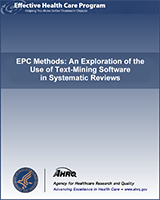NCBI Bookshelf. A service of the National Library of Medicine, National Institutes of Health.
Structured Abstract
Objective:
This project's goal was to provide a preliminary sketch of the use of text-mining tools as an emerging methodology within a number of systematic review processes. We sought to provide information addressing pressing questions individuals and organizations face when considering utilizing text-mining tools.
Methods:
We searched the literature to identify and summarize research on the use of text-mining tools within the systematic review context. We conducted telephone interviews with Key Informants (KIs; n=8) using a semi-structured instrument and subsequent qualitative analysis to explore issues surrounding the implementation and use of text-mining tools. Lastly, we compiled a list of text-mining tools to support systematic review methods and evaluated the tools using an informal descriptive appraisal tool.
Results:
The literature review identified 122 articles that met inclusion criteria, including two recent systematic reviews on the use of text-mining tools in the screening and data abstraction steps of systematic reviews. In addition to these two steps, a preliminary exploration of the literature on searching and other less-studied steps are presented. Support for the use of text-mining was strong amongst the KIs overall, though most KIs noted some performance caveats and/or areas in which further research is necessary. We evaluated 111 text-mining tools identified from the literature review and KI interviews.
Conclusions:
Text-mining tools are currently being used within several systematic review organizations for a variety of review processes (e.g., searching, screening abstracts), and the published evidence-base is growing fairly rapidly in breadth and levels of evidence. Several outstanding questions remain for future empirical research to address regarding the reliability and validity of using these emerging technologies across a variety of review processes and whether these generalize across the scope of review topics. Guidance on reporting the use of these tools would be useful.
Contents
Prepared for: Agency for Healthcare Research and Quality, U.S. Department of Health and Human Services1, Contract No. 290-2012-00004-C (SRC), 290-2012-00009-I (Vanderbilt), 290-2012-00011-I (ECRI). Prepared by: Scientific Resource Center, Portland, OR
Suggested citation:
Paynter RA, Bañez LL, Berliner E, Erinoff E, Lege-Matsuura J, Potter S, Uhl S. EPC Methods: An Exploration of the Use of Text-Mining Software in Systematic Reviews. Research White Paper. (Prepared by the Scientific Resource Center and the Vanderbilt and ECRI Evidence-based Practice Centers under Contract Nos. 290-2012-00004-C [SRC], 290-2012-00009-I [Vanderbilt], and 290-2012-00011-I [ECRI].) AHRQ Publication 16-EHC023-EF. Rockville, MD: Agency for Healthcare Research and Quality; April 2016. www.effectivehealthcare.ahrq.gov/reports/final/cfm.
This report is based on research conducted by the Scientific Resource Center, Vanderbilt, and ECRI Evidence-based Practice Centers (EPC) under contract to the Agency for Healthcare Research and Quality (AHRQ), Rockville, MD (Contract Nos. 290-2012-00004C [SRC], 290-2012-00009I [Vanderbilt], and 290-2012-00011I [ECRI]). The findings and conclusions in this document are those of the authors, who are responsible for its contents; the findings and conclusions do not necessarily represent the views of AHRQ. Therefore, no statement in this report should be construed as an official position of AHRQ or of the U.S. Department of Health and Human Services.
None of the investigators have any affiliations or financial involvement that conflicts with the material presented in this report.
The information in this report is intended to help health care decision makers—patients and clinicians, health system leaders, and policymakers, among others—make well-informed decisions and thereby improve the quality of health care services. This report is not intended to be a substitute for the application of clinical judgment. Anyone who makes decisions concerning the provision of clinical care should consider this report in the same way as any medical reference and in conjunction with all other pertinent information, i.e., in the context of available resources and circumstances presented by individual patients.
AHRQ or U.S. Department of Health and Human Services endorsement of any derivative products that may be developed from this report, such as clinical practice guidelines, other quality enhancement tools, or reimbursement or coverage policies may not be stated or implied.
- 1
5600 Fishers Lane, Rockville, MD 20857; www
.ahrq.gov
